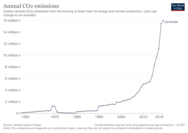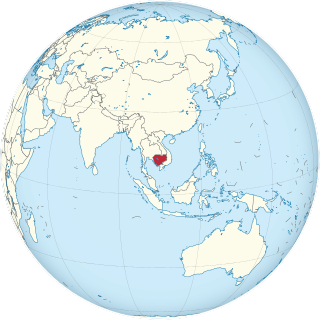
Cambodia is a country in mainland Southeast Asia. It borders Thailand, Laos, Vietnam, the Gulf of Thailand and covers a total area of approximately 181,035 km2 (69,898 sq mi). The country is situated in its entirety inside the tropical Indomalayan realm and the Indochina Time zone (ICT).
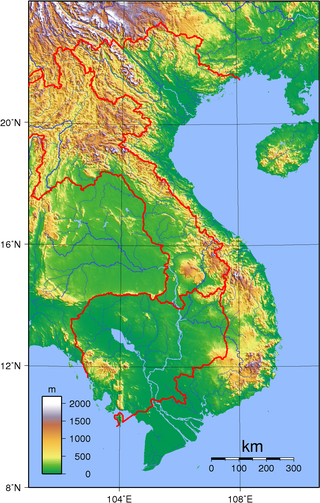
Vietnam is located on the eastern margin of the Indochinese peninsula and occupies about 331,211.6 square kilometres (127,881.5 sq mi), of which about 25% was under cultivation in 1987. It borders the Gulf of Tonkin, Gulf of Thailand, and Pacific Ocean, along with China, Laos, and Cambodia. The elongated roughly S shaped country has a north-to-south distance of 1,650 km (1,030 mi) and is about 50 km (31 mi) wide at the narrowest point. With a coastline of 3,260 km (2,030 mi), excluding islands, Vietnam claims 12 nautical miles as the limit of its territorial waters, an additional 12 nautical miles as a contiguous customs and security zone. It has an exclusive economic zone of 417,663 km2 (161,261 sq mi) with 200 nautical miles.

The Mekong or Mekong River is a trans-boundary river in East Asia and Southeast Asia. It is the world's twelfth-longest river and the third-longest in Asia with an estimated length of 4,909 km (3,050 mi) and a drainage area of 795,000 km2 (307,000 sq mi), discharging 475 km3 (114 cu mi) of water annually. From its headwaters in the Tibetan Plateau, the river runs through Southwest China, Myanmar, Laos, Thailand, Cambodia, and southern Vietnam. The extreme seasonal variations in flow and the presence of rapids and waterfalls in the Mekong make navigation difficult. Even so, the river is a major trade route between Tibet and Southeast Asia. The construction of hydroelectric dams along the Mekong in the 2000s through the 2020s causes serious problems for the river's ecosystem, including the exacerbation of drought.

Tonlé Sap is a lake in the northwest of Cambodia. Belonging to the Mekong River system, Tonlé is the largest freshwater lake in Southeast Asia and one of the most diverse and productive ecosystems in the world. It has been designated as a Biosphere Reserve by UNESCO in 1997 due to its high biodiversity. In the 21st century, the lake and its surrounding ecosystems are under increasing pressure from deforestation, infrastructure development and climate change.
Climate change is an urgent and significant issue affecting Japan. In recent years, the country has observed notable changes in its climate patterns, with rising temperatures serving as a prominent indicator of this phenomenon. As an archipelago situated in northeastern Asia, Japan is particularly vulnerable to the impacts of climate change due to its diverse geography and exposure to various weather systems. The nation experiences a broad range of climates, spanning from the frigid winters of Hokkaido to the subtropical climates of Okinawa. Changes in temperature patterns have the potential to disrupt ecosystems, impact agricultural productivity, modify water resources, and pose significant challenges to infrastructure and human settlements.
This page describes energy and electricity production, consumption and import in Laos.
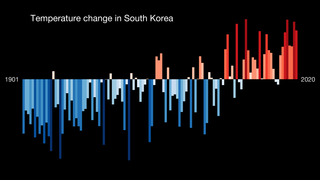
Climate change has led to extreme weather events in South Korea that affects: social, economy, industry, culture, and many other sectors. South Korea is experiencing changes in climate parameters. Such parameters include annual temperature, rainfall amounts, and precipitation.

There are numerous effects of climate change on agriculture, many of which are making it harder for agricultural activities to provide global food security. Rising temperatures and changing weather patterns often result in lower crop yields due to water scarcity caused by drought, heat waves and flooding. These effects of climate change can also increase the currently-rare risk of several regions suffering simultaneous crop failures, which would have significant consequences for the global food supply. Many pests and plant diseases are also expected to either become more prevalent or to spread to new regions. The world's livestock are also expected to be affected by many of the same issues, from greater heat stress to animal feed shortfalls and the spread of parasites and vector-borne diseases.
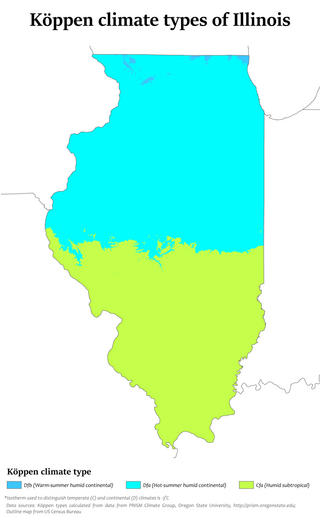
Climate change in Illinois encompasses the effects of climate change, attributed to man-made increases in atmospheric carbon dioxide, in the U.S. state of Illinois.
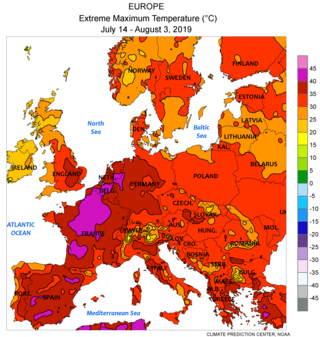
In France, climate change has caused some the greatest annual temperature increases registered in any country in Europe. The 2019 heat wave saw record temperatures of 46.0 °C. Heat waves and other extreme weather events are expected to increase with continued climate change. Other expected environmental impacts include increased floods due to both sea level rise and increased glacier melt. These environmental changes will lead to shifts in ecosystems and affect local organisms. Climate change will also cause economic losses in France, particularly in the agriculture and fisheries sectors.
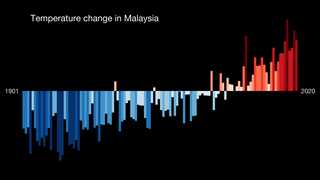
Climate change is having a considerable impact in Malaysia. Increasing temperatures are likely to greatly increase the number of heatwaves occurring annually. Variations in precipitation may increase the frequency of droughts and floods in various local areas. Sea level rise may inundate some coastal areas. These impacts are expected to have numerous environmental and socioeconomic effects, exacerbating existing environmental issues and reinforcing inequality.

Climate change is posing an increasing threat to global socio-economic development and environmental sustainability. Developing countries with low adaptive capacity and high vulnerability to the phenomenon are disproportionately affected. Climate change in Kenya is increasingly impacting the lives of Kenya's citizens and the environment. Climate Change has led to more frequent extreme weather events like droughts which last longer than usual, irregular and unpredictable rainfall, flooding and increasing temperatures.

Vietnam is among the most affected countries by global climate change. A large number of studies show that Vietnam is experiencing climate change and will be severely negatively affected in coming decades. These negative effects include sea level rise, salinity intrusion and other hydrological problems like floods, river mouth evolution and sedimentation. Natural hazards such as cold waves, storm surges will increase in frequency, with negative effects on the country's development, infrastructure and economy.
Climate change has caused temperatures in the world to rise in the last few decades, and temperatures in Europe have risen twice as fast as the average change in the rest of the world. In Spain, which already has a hot and dry climate, extreme events such as heatwaves are becoming increasingly frequent. The country is also experiencing more episodes of drought and increased severity of these episodes. Water resources will be severely affected in various climate change scenarios.

In Poland, climate change has resulted in an increase of average temperature above 2 degrees Celsius compared to preindustrial levels, which is higher than the average level of climate change in Europe. Temperature has been observed to increase over the last decades due to anthropogenic activity, and without significant reductions in greenhouse gas emissions the effects of climate change will become ever more noticeable.
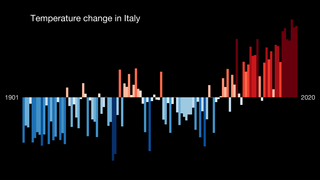
In Italy, widespread impacts of climate change are currently being felt. With an increase in extreme events such as heatwaves, droughts and more frequent flooding, Italy faces many challenges adapting to climate change.

Climate change in the Middle East and North Africa (MENA) refers to changes in the climate of the MENA region and the subsequent response, adaption and mitigation strategies of countries in the region. In 2018, the MENA region emitted 3.2 billion tonnes of carbon dioxide and produced 8.7% of global greenhouse gas emissions (GHG) despite making up only 6% of the global population. These emissions are mostly from the energy sector, an integral component of many Middle Eastern and North African economies due to the extensive oil and natural gas reserves that are found within the region. The region of Middle East is one of the most vulnerable to climate change. The impacts include increase in drought conditions, aridity, heatwaves and sea level rise.
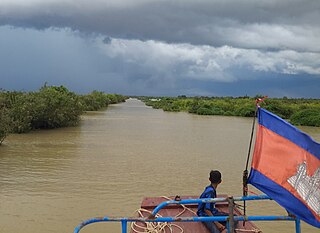
The Tonle Sap freshwater swamp forests ecoregion covers the seasonally flooded forests surrounding Tonlé Sap, the largest lake in Cambodia, and the floodplains of its connections to the Mekong River. Over 35% of the ecoregion experiences flooding during the wet season.

The Tonle Sap-Mekong peat swamp forests ecoregion covers a patchwork of areas permanently inundated with fresh water along the Tonle Sap River and Mekong River floodplains in Cambodia and Vietnam. The terrain is mostly flat, with extensive agricultural fields, reed beds, and degraded shrub forest. Less than 10% of the region is in its original state, and less than 1% is protected. Habitat in the region is distinguished from the Tonle Sap freshwater swamp forests ecoregion that runs through the middle, as that ecoregion is only seasonally flooded.
Climate change impacts are occurring in Zimbabwe, even though the country's contribution to greenhouse gas emissions is very minimal.

